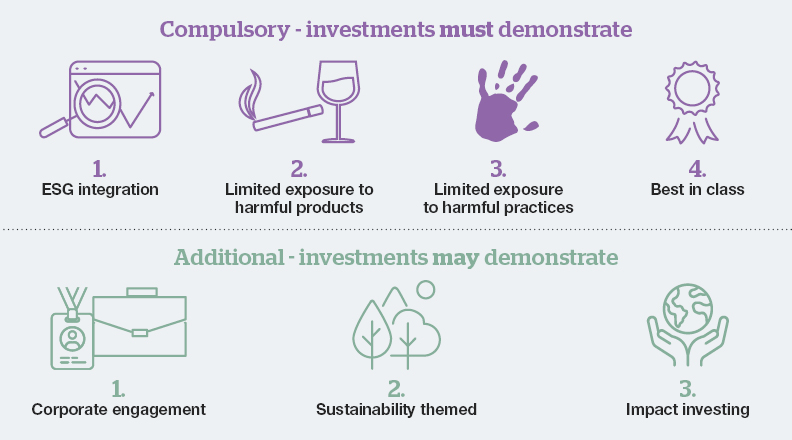We offer four global sustainable multi asset funds catering to a spectrum of different risk preferences and financial return targets. The funds aim to offer financial returns in excess of consumer price inflation (‘CPI’) over any given five-year period. These return targets range from CPI+1% for our lowest risk, Defensive Sustainable fund up to CPI+4% for our higher risk Growth Sustainable fund, reflecting the need to take on greater risk in order to create the potential for higher returns.
The sustainable funds are actively managed within the same investment process as our core funds, while the sustainable credentials of a potential investment are assessed against our sustainable investment policy. All investments are tested against the policy’s criteria by our Sustainable Investment Committee.
How we approach sustainable investing
Our sustainable investment process combines a number of recognised sustainable investment techniques* with a long-term approach to investment risk and return. Below are the sustainable investment criteria we look for when building our sustainable strategies. All of our investments must fulfil the compulsory criteria, while some of our investments will meet the ‘additional’ criteria.
We believe that the integration of positive environmental, social and governance considerations (ESG) can have a material effect on the valuations of the investments we make. The extent of that effect though will vary across asset classes and security types, meaning we do not take a ‘one-size fits all’ approach to ESG integration. This applies as much to our investment decisions, as it does to the third-party managers in whose funds we may invest.
We test ESG integration within our investment decision-making using a points-based scoring framework. The scores obtained enable our Sustainable Investment Committee to measure the degree of conviction that a manager may be displaying in the integration of ESG factors into their investment decision-making, as well as a comparison across different approaches to ESG integration.
*These are often used to evaluate sustainability in investments. ‘Environmental’ refers to natural resources and pollution; ‘social’ refers to effects on people and communities; governance refers to how organisations (corporate, local or national) are run.
Limited exposure to products that are harmful to our society and our planet
We recognise that many investors wish to align their values with their investment decisions and we observe increasing levels of consensus around the products that are harmful to our society and our planet. We reflect these consensus values in our investment process by screening out our exposure to harmful products, using the amount of revenue these products generate as our measure.
Core exclusions reflect our strongest convictions, and represent areas where society appears to demonstrate its greatest consensus through laws and conventions. These are controversial weapons and tobacco.
Non-core exclusions are areas where society has typically chosen to regulate and mitigate rather than prohibit potential harms and drive them underground. These are alcoholic beverages, fur & leather, gambling, adult entertainment, predatory lending, palm oil, and fossil fuels. Investments may be excluded if they derive revenue from these categories over a defined tolerance threshold. These tolerance levels are described fully in the sustainable investment policy.
Sustainable Investment PolicyLimited exposure to practices that are harmful to our society and our planet
Identifying harmful practices requires a more nuanced approach than for harmful products, and we therefore screen potential investments for controversial behaviours using a matrix derived from internationally-recognised standards*, which relates to Human Rights, Labour, Environment and Anti-corruption. We will not intentionally invest where we identify a breach of these standards.
* The United Nations Global Compact has been adopted by 22,356 participants across 162 countries. It is fast becoming the go-to set of principles which underpins Corporate Sustainability and can be viewed as a baseline for Responsible Business Conduct. The Ten Principles | UN Global Compact
Actively seeking out ‘best in class’ management of ESG risks
To identify these opportunities we implement ‘best-in-class’ screening to find which intended investments are managing their ESG risks better than their sector, asset class, or industry peers. We use multiple ESG risk scores in our analysis. When considering new investments, we expect their ESG risk scores to demonstrate better management of ESG risks when compared to their peers. On at least a quarterly basis, ESG risk scores are monitored across our funds and any directional change prompts further scrutiny from the Sustainable Investment Committee.
As well as adhering to the compulsory criteria, some of our investments may go a step further and demonstrate characteristics in line with the additional criteria: corporate engagement, sustainability themed, and impact investing.
This could mean investing in businesses which employ shareholder power to influence corporate behaviour, through corporate engagement programmes. It could also mean investing in sustainable themes, or assets specifically contributing to sustainable solutions - environmental and social - (for example, sustainable agriculture, green buildings, lower carbon tilted portfolio, gender equity, diversity).
Finally, it could mean investing to achieve positive, social and environmental impacts, often referred to as ‘impact investing.’ For investments to be classed as impact investments, the managers must be able to measure and report the impact these investments are having, and make clear that these impacts are intentional and meaningful.
Find our more about each of our individual sustainable multi asset funds
Sustainable investment policy
An introduction to our Sustainable Fund range
Handelsbanken Asset Management and The UK Sustainable Investment and Finance Association
We are proud to be a member of The UK Sustainable Investment and Finance Association (UKSIF), as a way of demonstrating our commitment to creating a more sustainable and responsible finance system in the UK. UKSIF membership allows us to collaborate on pioneering new research within UKSIF projects, and also gives us access to knowledge on emerging issues and key contacts within the sustainable industry.
Find out more about our core and income funds






